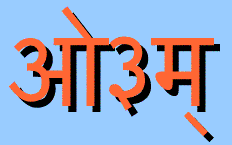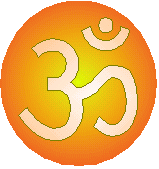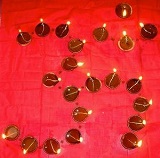Om Symbol - ॐ
This page has little mythology! The Om symbol is discussed here as a symbol (letter) and also as a word (syllable/sound).
Hinđī and Sanskṛiŧ words are written in Roman as well as in the ĐevaNāgarī Alphabet.
What is Om?
It is the smallest manŧra (मंत्र). It is also called mūl-manŧra; mūl (मूल) means fundamental and primordial. Some also call it praṇav-manŧra. 'Praṇav' (प्रणव) means strong/powerful.
A shlok (श्लोक) is a Sanskṛiŧ verse, typically of two line. A manŧra is a phrase (or rarely a word) used for meditation and chanting.
Sacred ancient Indian texts like Veđ (वेद), are collections of shlok/s. Some of these shlok/s are used as manŧra/s.
It is a common practice to begin other manŧra/s with Om, like -
1. 'Om namaḥ Shivāya' - ॐ नमः शिवाय,
2. 'Om shānŧi(ħ) shānŧi(ħ)' - ओम शांति: शांति:.
Jainism, Buđđhism and Sikhism originated from India after Hinđūism. These religions adopted some of the Hinđū philosophies and practices. These religions have their own forms and understandings of 'Om'.
Hinduism, Jainism, Buddhism, and Sikhism are together referred as Đhārmik (धार्मिक, Dharmic) religions. Some followers of Đhārmik religions believe that 'Om' is the ultimate, hyper or super-natural sound!
In ĐevaNāgarī, this word can be written as 'ओम्' or 'ओम'. It is general practice in Hinđī to drop the last 'halant' ('्'). So 'ओम' is generally preferred over 'ओम्'. The spelling 'ओम' is used in literature (mostly as noun); while the symbol 'ॐ' is used for religious purposes.
The Meaning of Om or AUm
We are not yet very sure of the precise meaning of the word 'Om'! It is certainly related to the God or Heaven! Twelve verses of Veđ collectively called Māṇdūk`ya Upaniṣhađ (माण्डूक्य उपनिषद) tries to explain this sacred word 'AUm'.
As per the Sanskṛiŧ grammar (Vyākaraṇ; व्याकरण) the vowel 'O' (ओ) is sometimes substituted for two consecutive vowels 'A' (अ) and 'U' (उ); Generaly public too prefer 'Om' instead of 'AUm' (अ-उ-म्)!
Gāyaŧrī Manŧra (गायत्री मंत्र) like many other Veđik shlok/s starts with Om. That's why I assumed that Om (ओम) means 'O my (our) Lord' ('हे परमेश्वर'); I may be wrong.
Some people say there is a relation between the words 'Om' and 'Amen'; others doubt it!
The Om symbol - ओंकार
An 'Om symbol' is a sign (glyph, shape) to write (scribe, represent) the 'Om' sound.
'Om symbol' is called 'Oṅkār' (ओंकार=ओङ्कार) or 'Omkār' (ओम्-कार).
As discussed earlier, the 'Om' sound can be written as 'ओम' in ĐevaNāgarī. So 'ॐ' is a symbol of the word 'ओम' in ĐevaNāgarī.
People use this sign/symbol for meditation and worship.
Om symbol is drawn mostly as in the picture below i.e. as 'ॐ'.
If you want a bigger picture of the 'Om symbol', click the above picture.
Is Om a religious symbol?
YES. It is the main religious symbol for Hinđū/s and Buđđhists (Bauđđh; बौद्ध). Sikhs have a derived form called 'एक ओंकार' ('Ek Oṅkār').
In Hinđī and Sanskṛiŧ,
shape = Ākār (आकार) or Ākṛiti (आकृति)
glyph = Akṣhar (अक्षर) or Akṣharākṛiti (अक्षराकृति)
indicate = san'ket (संकेत)
symbol = san'ket + Akṣhar (संकेत-अक्षर)
san'ket + Akṣhar = san'ketākṣhar (संकेताक्षर)
sign = chihn (चिह्न)
In Hinđī 'đharm' means religion (or religious duty). A religious symbol can be called a đhārmik chihn (धार्मिक चिह्न).
What is ओ३म् (O3m)?
Đayānanđ Sarasvaŧī (दयानन्द सरस्वती) was the founder of the 'Ārya Samāj'. He used to write 'ओ३म्' instead of 'ओम'. The '३' (ĐevaNāgarī digit 3) between 'O' and 'm' is called 'plūŧ' (प्लूत). Đayānanđ used 'plūŧ' to emphasize long pronunciation of 'O'. Members of 'Ārya Samāj' prefer 'ओ३म्' instead of 'ॐ'.
So 'ओ३म' is to be pronounced as OOOm (o..m).

Is Om the most powerful symbol?
There is no scientific study to prove that the 'ॐ' is better or more powerful than any other symbol or letter for meditation etc. No symbol can bring good luck, wealth or power. This symbol is sometimes misused by greedy preachers.
Can Om symbol help you in meditation?
IMHO, if a dark circle (or a point) can help you in meditation then the Om symbol can also help!
Proper Use of Om
Someone wrote that a reverse (flipped) Om brings bad luck. Luckily most Hinđū/s do not believe in such nonsense. If you care for sentiments of the Hinđū/s (who are mostly peace-loving), avoid drawing this symbol on footwear, near dirty places, etc. If you want to make tattoos of this symbol, please try to maintain the shape and avoid tattooing it on leg, thigh, etc.
The font 'Akhil HE' is used in the following paragraph to typeset the 'Gāyaŧrī Manŧra' in the smallest possible size.
![[Gāyaŧrī Manŧra: small text]](https://www.omgayatri.com/mahaa_maNtra/gayatri_64.png)
No other font can render equally clear text of Gāyaŧrī Manŧra with all the marks at this size!
Give it as a Gift.
This font 'Akhil HE' is a great gift for some. So buy a single user license for yourself or someone important to you. This font is based on latest standards and technologies, so it will continue to work in future versions of Windows, Android and Linux.
It is economical, click the above button either to check the price or to buy.
Please enter your email and click 'Recommend It' to receive the address of this page and related pages in your inbox. You can then send this page to your friend(s).
![[[]]](https://www.omgayatri.com/pRiShTh/space-in-heading.png)


